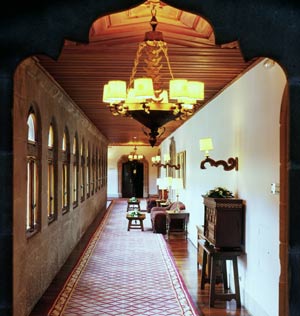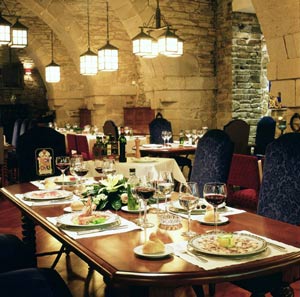About the Parador of Santiago de Compostela

Certainly, one of the most luxurious and beautiful hotels in Spain. The Parador de Santiago, known as the Hostal dos Reis Católicos, is a blend of history, art and tradition, the dream of pilgrims and emblem of Santiago. This 5* luxury hotel is located on Obradoiro Square near the cathedral, creating an area of spectacular beauty in one of the most visited provincial capitals in the world. The exclusivity of the location, the quality of the accommodation and the cuisine on offer makes it a perfect place to stay in the City of the Apostle.

The building was originally built as a hospital for the pilgrims on the instructions of the Reyes Católicos in 1499 and designed by Enrique Agas. The architecture style is known as Plateresque with Gothic influences on its main facade; a masterwork of the two Frenchmen Martin de Blas and Guile Colas dating from 1520.
The Hostal de los Reyes Catolicos in Santiago de Compostela is considered to be one of the oldest continuously operating hotels in the world, and one of the finest Spanish Paradors.

If you look at the lower part of the facade, you will see a high relief of Adam and Eve, of Saint Catherine of Alexandria and Saint Lucia, who is carrying her eyes on a tray, and of John the Baptist and Mary Magdalene.
The six high reliefs that crown the facade are Saint Peter, Saint James the Greater the Saviour, the Virgin Mary, Saint John and Saint Paul. In the medallions, are the faces of the so-called Catholic king and queen, Fernando and Isabel.
For those not staying in the Parador, we recommend visiting the common areas. This can be organised as part of our Santiago de Compostela Guided Tours or self-guided for only 3€.
Inside the chapel, declared “Monument of Historic Art” in 1912, is a real gem. The magnificent starred vault was the work of Juan de Alava who used stones from Coimbra.

There are four beautiful and relaxing interior cloisters, two of which are Renaissance and the other two being Baroque and the hotel regularly holds art exhibitions in the bars and corridors.

And finally, it is worth noting that the cuisine of the hotel’s restaurant with its vaulted main salon is among the finest in the area.
The prestigious Paradores de Turismo de España hotel chain
Paradores de Turismo de España is a chain of luxury hotels run by the Spanish government. The hotels range from 3 to 5* luxury all over the Iberian Peninsula including Portugal and are always located in remarkable landmark buildings or sites that have been chosen for their historical, artistic or cultural interest.
Their unique locations, the knowledge of their local chefs and the beauty of their architecture makes some Paradores a must-visit in many Spanish Cities.
A little bit of history of the Parador Chain

The concept of the Paradores dates back to 1926 when the Marquis de la Vega-Inclán asked the King Alfonso XIII of Spain to allow the construction of a luxury hotel in the Sierra de Gredos.
The hotel, which opened in 1928, was quite a success. Following the grand opening, the Board of Paradores and Inns of the Kingdom was formed. The original idea was to build luxury hotels in places that could not be used by private ventures although enjoying ideal conditions to attract tourism, such as monasteries, convents, fortresses, palaces, castles or buildings in protected areas. It was also a way to take advantage and rehabilitate some abandoned historical and artistic monuments.

The Portuguese equivalent, the Pousadas de Portugal, were founded in 1942, after the Spanish model. In France, they are similar to the Relais et Châteaux.
The following to open were the Ciudad Rodrigo (Salamanca) in 1929, the Oropesa (Toledo) and Ubeda (Jaen) in 1930 and Mérida (Badajoz) in 1933.
The greatest expansion process occurred in the 1960s, coinciding with a major tourism development project led by Franco. In a few years, the network of Paradores went from 40 to 83 hotels.
In the 1980s, the chain merged with another Spanish public chain Entursa which gave the Parador two of it’s most emblematic monuments hotels: the Hostal de los Reyes Catholics in Santiago de Compostela and the Hostal de San Marcos in Leon (which can be seen in the movie The Way).

The Hostal de San Marcos is one of the most extraordinary historic hotels on the Old Continent. Construction of the building began in the 16th century, together with the bridge across the River Bernesga in the outskirts of León. It was built to house the peninsula’s western headquarters for the Military Order of Saint James. The project was financed by King Ferdinand the Catholic. The magnificent hotel is a museum of stately function rooms, with a spectacular cloister and chapter house; spacious, elegant guest rooms; a library; and a wonderful restaurant that offers beautifully prepared traditional cuisine.
In the 1990s, Paradores experienced a fundamental change that made it a private entity. On January 18, 1991, the chain became the Paradores of Spain, SA (Anonymous Corporation). The aim was to make the hotel chain a profitable company which exclusively would only use their own benefits to maintain and operate their network.
Paradores today
Today, the network counts around 96 hotels from Galicia in the north-west through Catalonia to Andalusia in the south of Spain, the Canary Islands and to the Spanish cities in North Africa and to one in Portugal. Prices usually vary according to room, region and season. They often have great special promotions off season (November, January, March).
Paradors are classified within ‘Esentia’ monumental and historic hotels, ‘Civia’ urban hotels, and ‘Naturia’ hotels to enjoy the coast and nature.
Here is a map of the different locations where you will find a Parador:

You can also find more information on their website www.parador.es/en or contact us to arrange to stay in any of their hotels.